Andrea Nguyen’s Herby Oven-Steamed Eggs
One of the dishes I most fondly remember my Mom making when I was a kid was a Chinese savory custard, redolent of seasoned ground pork and with a surprise duck egg yolk the color of a Hawaiian sunset hidden at its very center.
I also remember her expression when it did not turn out perfectly smooth.
She’d wait till it was done steaming to lift the lid to reveal the outcome. If it had a bubbly interior, she would frown and fret — even if the taste was still delicious. But if it was as smooth as creme brulee, she would take it as a personal triumph.
I thought of my late-Mom when I spied “Herby Oven-Steamed Eggs” in the new “Vietnamese Food Any Day: Simple Recipes for True, Fresh Flavors” (Ten Speed Press), of which I received a review copy. It’s the latest and greatest by my friend and colleague, award-winning Bay Area food writer Andrea Nguyen.
As the name implies, this cookbook aims to streamline Vietnamese dishes so you can enjoy the vibrant flavors of the cuisine any day of the week without special trips to Asian markets.
She’s come up with genius advice, such as to use pomegranate molasses if you can’t easily find tamarind paste to make a riff on a Southern Vietnam favorite, “Pomegranate Sriracha Shrimp.” Or to make soothing rice porridge without the usual hours-long cooking, by simply soaking cooked leftover rice overnight before simmering for a mere 15 minutes for “Super-Simple Overnight Rice Porridge.” Or to enjoy traditional screw pine-flavored waffles but to use the more easily found matcha instead in “Matcha ‘Pandan’ Waffles.”
My Mom used to make her porky egg custard in a glass pie plate, elevated with a steaming rack in a wide pot filled with a couple inches of water. Similarly, trứng hấp (Vietnamese steamed eggs) is also typically made by cooking in a steamer on the stove-top.
But what if you don’t have a steamer? Or what if you want to make individual ramekins to feed a crowd and don’t have a way to steam them all at once on the stove-top?
Then, follow Nguyen’s brilliant method to cook them in the oven in a water-bath a la creme brulee. It guarantees a polished egg custard every time. What’s more, as Nguyen notes, it actually makes for a richer tasting custard.
Trứng hấp, she adds, is sometimes referred to as Vietnamese meatloaf. Unlike Japanese chawanmushi, which is mostly custard with only a few added filling ingredients, this is denser and quite meaty, fortified with a good amount of pork plus bean thread noodles, with eggs just binding everything together. Nguyen also provides a vegetarian version made with mushrooms.
Just stir the soaked, chopped noodles together with the pork, herbs, fish sauce, water and eggs, then divide the mixture among ramekins. I actually had 4-ounce ramekins, so I ended up filling seven of them.
Place the filled ramekins in a pan, fill half-way with hot water, cover with foil, and slide into the oven. There’s no monitoring of the water to see if it’s bubbling too aggressively, as my Mom used to do. The oven ensures the cooking is even-keeled and gentle.
The baked custards can be enjoyed hot or at room temperature. Nguyen suggests serving with a salad or rice, or spreading it on crackers or cucumber slices. I think they’re perfect served with a fluffy mound of rice alongside garlicky sauteed Asian greens.
It’s a spoonful of comfort with a big backbone of meatiness. And it’s smooth, smooth, smooth — just the way my Mom would have rejoiced in.
Herby Oven-Steamed Eggs
(Serves 4 to 7, depending upon the size of your ramekins)
1 1/2 ounces dried glass noodles (saifun or bean thread noodles)
6 ounces ground pork (about 85 percent lean) or ground turkey thigh or chicken thigh
1/3 cup finely chopped shallot or yellow onion
1/4 cup lightly packed chopped fresh cilantro, basil, or parsley
2 tablespoons fish sauce
1 tablespoon canola or other neutral oil
1/2 teaspoon plus 1/8 teaspoon recently ground black pepper
Rounded 1/2 teaspoon sugar
1/2 cup plus 1 tablespoon water
5 eggs
Chile garlic sauce, sriracha or sambal oelek (optional, for heat seekers)
In a mixing bowl or 4-cup measuring cup, soak the noodles in hot water for 5 to 10 minutes, until pliable.
Meanwhile, preheat the oven to 325 degrees. Bring a kettle of water to a boil, turning the heat to low to keep it hot, if needed. Select a baking dish about 2 inches deep and large enough to hold four 8-ounce ramekins, about 4 inches in diameter; or six 5 1/2 ounces ramekins, about 3 1/2 inches in diameter. A dish with handles makes transporting easier.
Drain the noodles and then chop into short rods, no longer than 3/4 inch, and return them to the mixing bowl. Add the pork, shallot, cilantro, fish sauce, canola oil, pepper, and sugar and use a fork to vigorously mash, stir, and fold to break up the meat and mix well. Add the 1/2 cup plus 1 tablespoon water, stirring until incorporated, then add the eggs, stirring and beating to thoroughly mix.
Stir the egg mixture again and divide among the ramekins. Transfer the ramekins to the baking dish and pour in enough hot water to come halfway up the sides of the ramekins. Cover the baking dish with aluminum foil and slide into the oven.
Bake for 35 to 40 minutes, then check the progress; the tops should be domed, look opaque, and feel firm to the touch. When you insert a toothpick, a little liquid should emerge. If needed, bake 5 minutes longer and recheck. The baking time will depend on the baking dish material and the size of the ramekins.
Remove from the oven and let the ramekins rest in the baking dish for 5 minutes, loosely covered by the foil. Then, using tongs or oven mitts, carefully remove the ramekins. When cooling, the buttercup-colored tops will turn a less pretty light beige, but the good flavor will remain.
Serve the eggs hot, warm, or at room temperature, with the chile sauce, if you like.
Notes: Leftovers will keep, covered in the refrigerator for up to 3 days. To reheat, microwave the individual ramekins for 20 to 30 seconds.
For a vegetarian version: Make mushroomy oven-steamed eggs by omitting the meat and substituting 8 ounces chopped cremini or white mushrooms (include caps and stems, and chop by hand or in a food processor; aim for pinkie-nail-wide pieces). Cook the mushroom in a large skillet over medium-high heat with 1 tablespoon canola oil and season with several big pinches of salt. When they’re half their original volume, after 2 to 3 minutes, remove from the heat and let rest for 5 minutes. Mix the mushrooms with the noodles, shallot, oil, pepper, and sugar. Add 3 tablespoons chopped cilantro, 1 1/2 tablespoons fish sauce (or 1 tablespoon soy sauce plus a rounded 1/2 teaspoon fine sea salt), the water, and 6 eggs. Bake as directed.
Another Oven-Steamed Dish to Try:Â Oven-Steamed Fish with Crispy Garlic and Red Chile Oil
More Andrea Nguyen Recipes to Enjoy:Â Panfried Pho Noodles
And: Sri Lankan Black Curry Chicken Banh Mi
And: Roast Chicken with Red Fermented Tofu
And: Baked Char Siu Buns

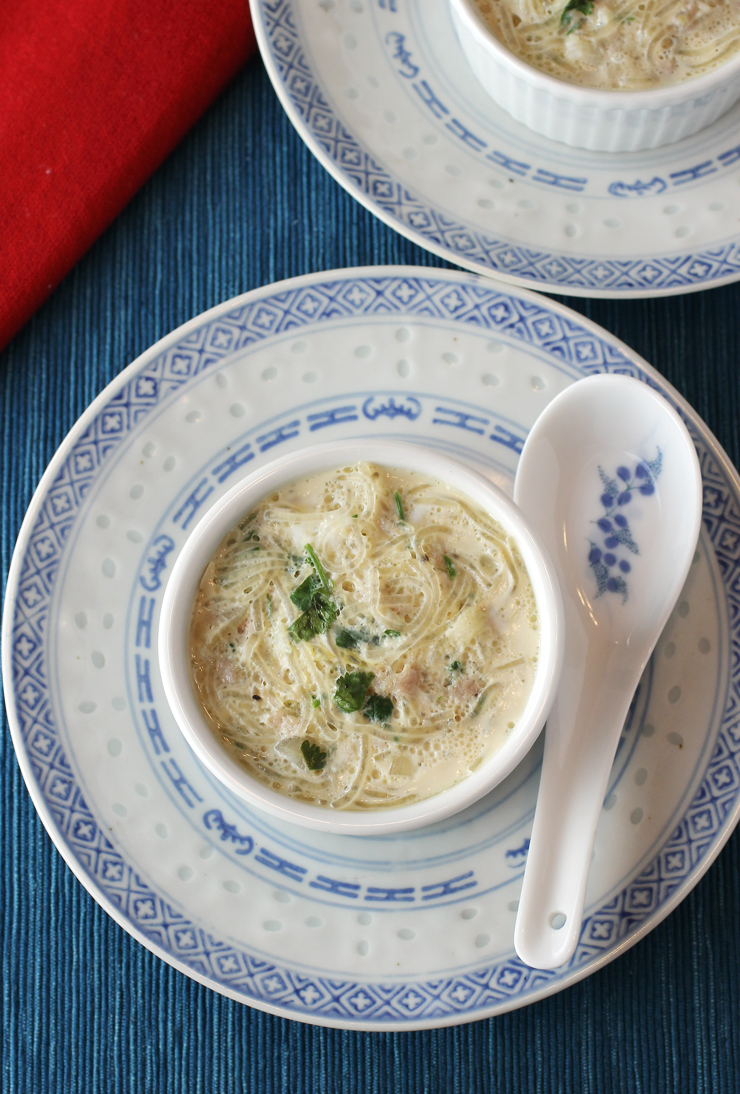
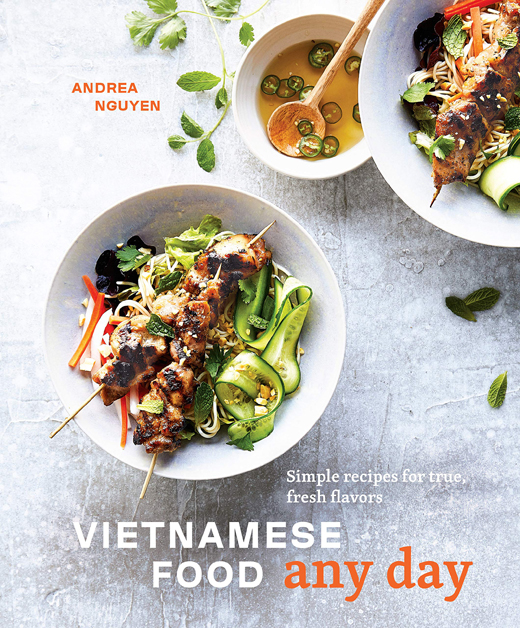
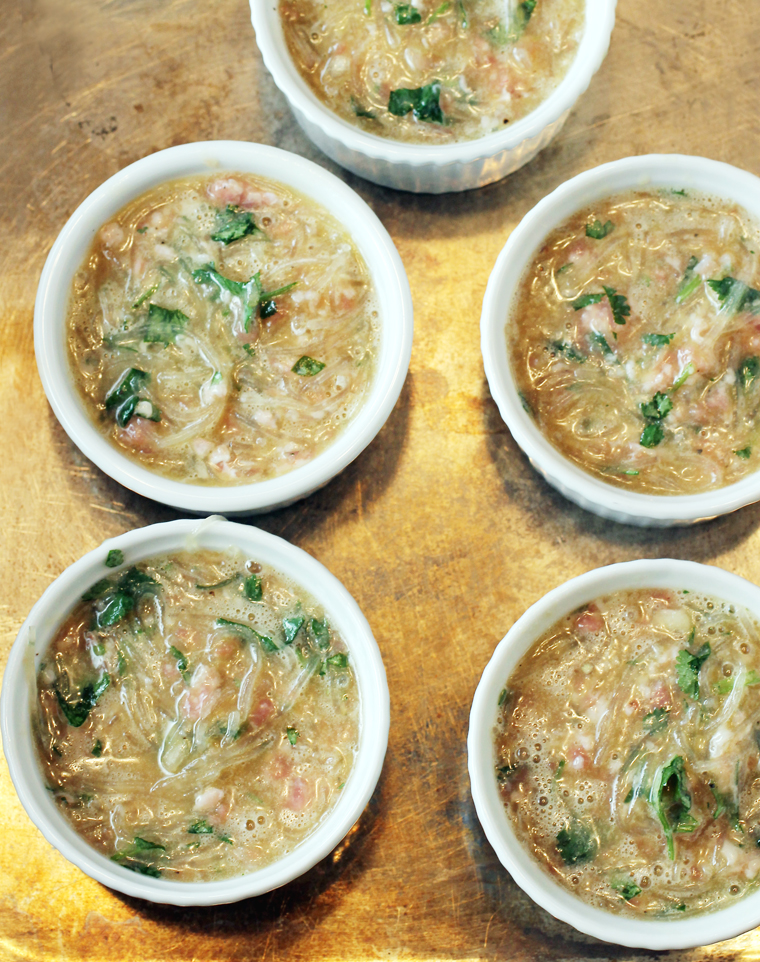
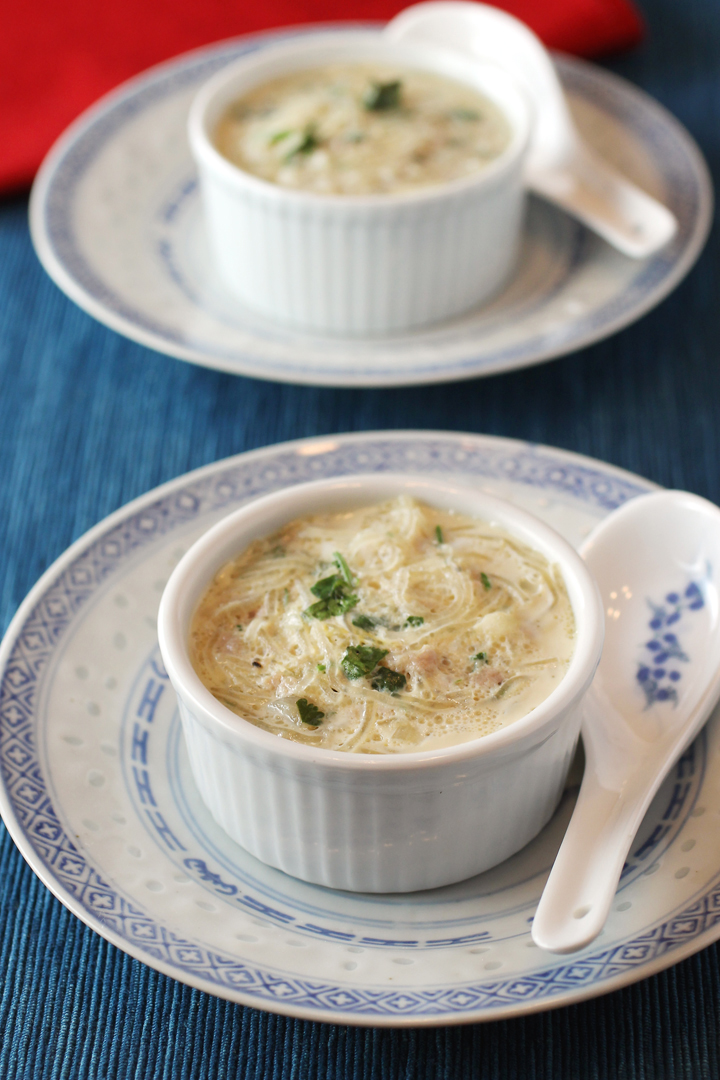
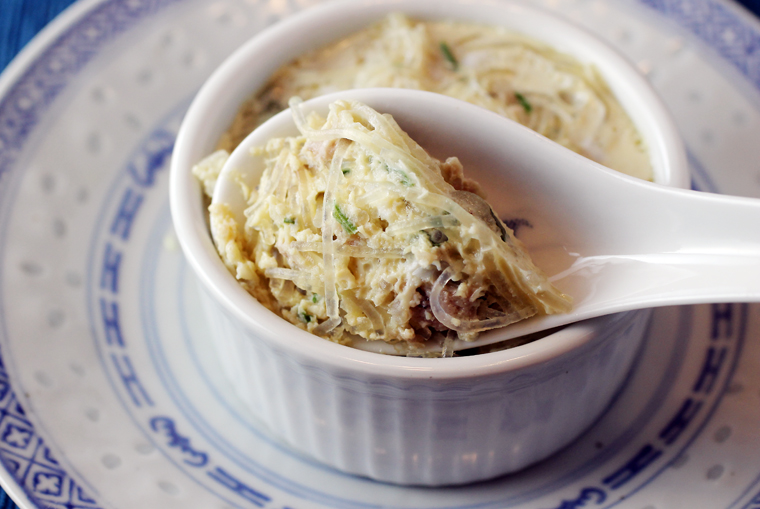
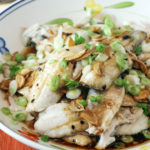
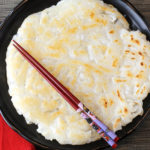
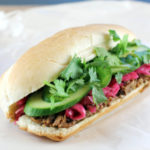
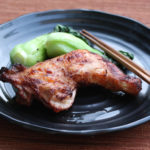
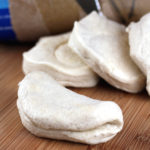
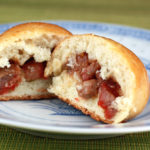
Yum. I personally liked the bubbly texture. 🙂
Oh my…
Going to try this!
Ying: I hope you enjoy it! Happy cooking!
I cried when I read about your mother. It made me sad, thanks for sharing.
Linda: I didn’t mean to make you shed tears, but I’m touched that the memories of my Mom hit such a deep chord with you. I miss her every day. But I’m glad the taste of certain foods will always make me think of her profoundly.